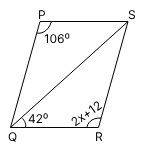Triangles and Congruence: Definition, Calculator, Questions, Formula
Triangles and congruence are fundamental parts of geometry, where we learn in which conditions two triangles are considered congruent. Here we will discuss what is congruency, the criteria of congruent triangles, the properties of congruent triangles, differences between similar and congruent triangles, triangles and congruence worksheet, triangles and congruence answer key, triangles congruence and similarity, triangles and congruence proofs, triangles and congruence quiz, triangles congruence statement, triangles congruence theorems, triangle congruence postulates, triangle congruence and proofs worksheet etc.
- Triangles and Congruence: An Overview
- Meaning of Congruent
- Congruent Triangles
- Criteria of Congruency of Two Triangles/ Triangle Congruence Theorem
- Writing congruence Statement:
- What is CPCT?
- Properties of Congruent triangles
- Difference between Similar triangles and congruent triangles
- Tips and Tricks
- Practice Questions/Solved Examples
Triangles and Congruence: An Overview
Triangles are a type of geometric shape, which has three sides, three angles, and three vertices. Triangles can be classified into various forms depending on their sides and angles. Congruent triangles are those which have the same shape and same size, this property is called as congruency of triangles.
Meaning of Congruent
Two figures are said to be congruent if they have identical shape and size. In other words, one congruent figure can be superimposed onto the other through some transformations, such as translation, rotation, or reflection.
Congruent Triangles
Congruent triangles are triangles that have the same three sides and the same three angles. If two triangles are congruent, each pair of corresponding sides and each pair of corresponding angles are equal.
Criteria of Congruency of Two Triangles/ Triangle Congruence Theorem
There are specific criteria used to determine if two triangles are congruent:
SSS (Side-Side-Side) Criterion: If all three sides of one triangle are equal to all three sides of another triangle, then the triangles are congruent.
Here AB = QR
BC = PR
And AC = PQ. So, the two triangles are congruent.SAS (Side-Angle-Side) Criterion: If two sides and the included angle of one triangle are equal to two sides and the included angle of another triangle, then the triangles are congruent.
Here AB = PQ
BC = QR
And included angles B and Q are equal.
So, the two triangles are congruent.RHS (Right Angle-Hypotenuse-Side) Criterion: In right-angled triangles, if the hypotenuse and one side of one triangle are equal to the hypotenuse and one side of another triangle, then the triangles are congruent.
Here AB = PQ
AC = PR
And included angles B and Q are each equal to 90 degrees.
So, the two triangles are congruent.AAS (Angle-Angle-Side) Criterion: If two angles and a non-included side of one triangle are equal to two angles and the corresponding non-included side of another triangle, then the triangles are congruent.
Here, Angles A and P are equal
Angles B and Q are equal
BC = RQ
AC = PR
So, the two triangles are congruent.
ASA (Angle-Side-Angle) Criterion: If two angles and the included side of one triangle are congruent to two angles and the included side of another triangle, then the triangles are congruent.
This criterion is not really required to be read separately as it was covered in the AAS criterion of congruency.
Writing congruence Statement:
When two triangles are congruent, we need to write a congruence statement. The order of the letters is very important, as corresponding parts must be written in the same order. If the letters are not written in the correct order then corresponding parts cannot be found perfectly.
Notice that the congruent sides also line up within the congruence statement.
Write a congruence statement for the two triangles below.
Here,
So,
Why it is so?
Since
TS = DE, and T and D are corresponding vertices. So, S and E must be written in front of each other.
The remaining two digits must be written correspondingly.
What is CPCT?
CPCT stands for "Corresponding Parts of Congruent Triangles." It is a principle that states that if two or more triangles are congruent, then all of their corresponding parts (sides and angles) are also congruent.
Properties of Congruent triangles
Corresponding sides are equal.
Corresponding angles are equal.
The areas of congruent triangles are the same.
The perimeters of congruent triangles are the same.
Difference between Similar triangles and congruent triangles
Similar Triangles: Similar triangles have the same shape but not necessarily the same size. Their corresponding angles are equal, and their corresponding sides are proportional.
Congruent Triangles: Congruent triangles have the same shape and size. All corresponding sides and angles are equal.
Tips and Tricks
Always look for corresponding parts when trying to prove triangle congruence.
Use congruence criteria (SSS, SAS, RHS, AAS) to identify congruent triangles quickly.
Remember CPCT to deduce additional equal parts once triangles are proven congruent.
Practice visualizing some transformations (translation, rotation, reflection) to understand congruence better.
Practice Questions/Solved Examples
Q.1.
In the given figure,

64°
74°
52°
82°
Hint: According to the properties of congruent triangles, two pairs of corresponding sides and the corresponding angles between them are equal.
Solution:
So, 106° = 2x + 12°
⇒ 106° – 12° = 2x
⇒ 94° = 2x
So, PQRS is a parallelogram.
Hence, the correct answer is option (2).
Q.2.
Which of the following statements is FALSE?
Two triangles are congruent if the size and shape of the triangles may or may not be equal.
SAS and SSS are both conditions of congruency of triangles.
If two angles and the included side of one triangle are equal to two angles and the included side of the other triangle, the triangles are congruent.
If two triangles are congruent, one of them can be superimposed on the other triangle.
Hint: We need both sizes and shapes to be equal for triangles to be congruent.
Solution:
Two triangles are congruent if they have the same shape and size.
In other words, the corresponding angles and sides of the two triangles are equal.
Congruent triangles are identical in shape and size.
So, the FALSE statement is ''Two triangles are congruent if the size and shape of the triangles may or may not be equal''.
Hence, the correct answer is option (1).
Q.3.
If
The ratio of AC to DF is
The perimeters of both the triangles are equal
AB = DE and BC = EF
The ratio of the angles in both the triangles is the same
Hint: When two triangles are found to be congruent, their corresponding sides and angles are also congruent.
Solution:
Given:
When two triangles are congruent, their corresponding sides and angles are also congruent.
Option 1: The ratio of AC to DF is
Option 2: The perimeters of both triangles are equal. This is correct.
Option 3: AB = DE and BC = EF. This is correct.
Option 4: The ratio of the angles in both triangles is the same. This is correct.
Hence, the correct answer is option (1).
Q.4.
For congruent triangles
Perimeter of
Perimeter of
Perimeter of
Perimeter of
Hint: The corresponding sides and angles of congruent triangles are equal.
Solution:
For congruent triangles
So,
So, perimeter of
Hence, the correct answer is option (2).
Q.5.

In the figure, AB = AD = 9 cm, AC = AE = 13 cm, and BC = 15 cm. Find ED.
18 cm
16 cm
14 cm
15 cm
Hint:
Solution:
Given: AB = AD = 9 cm, AC = AE = 13 cm, and BC = 15 cm.
⇒ ED = BC = 15 cm
Hence, the correct answer is option (4).
Q.6.
If m
AB = AC
BC = YZ
AB = XY
BC = AB
Hint: SAS Congruency: If two sides and the included angle of one triangle are equal to the corresponding two sides and the included angle of another triangle, the triangles are congruent.
Solution:

We have, m
If BC = YZ, then by SAS congruency rule ΔABC and ΔXYZ are congruent.
Hence, the correct answer is option (2).
Q.7.
Let ABC and PQR be two congruent triangles such that
12 cm
8 cm
10 cm
5 cm
Hint: By using Pythagoras' theorem: h2 = p2 + b2
Where h is the hypotenuse, p is the perpendicular, and b is the base.
Solution:

Given:
BC = 13 cm and PR = 5 cm
BC = QR and AC = PR
By using Pythagoras' theorem: h2 = p2 + b2
Where h is the hypotenuse, p is the perpendicular, and b is the base.
BC2 = AC2 + AB2
⇒132 = 52 + AB2
⇒ 169 – 25 = AB2
⇒ AB = 12
Hence, the correct answer is option (1).
Q.8.
If

7
6
9
13
Hint: Congruent triangles have the same corresponding sides and angles.
Solution:
Given:
We can say,
⇒
⇒
⇒
⇒
⇒
⇒
So,
⇒
Hence, the correct answer is option (3).
Q.9.
Two triangles XYZ and UVW are congruent. If the area of
58 cm2
116 cm2
29 cm2
15 cm2
Hint: The areas of two congruent triangles are equal.
Solution:
Two triangles XYZ and UVW are congruent.
The area of
We know,
The areas of two congruent triangles are equal.
Hence, the correct answer is option (1).
Q.10.
67
62
65
70
Hint: First, find the length of LO using Pythagoras theorem then prove that
Solution:

Given:
In
LO =
So, the perimeter of
Now, between
and LN = LN (general side)
So,
Therefore, the perimeter of
Hence, the correct answer is option (4).
Frequently Asked Questions (FAQs)
Congruent triangles are triangles that have exactly the same three sides and exactly the same three angles. If two triangles are congruent, each pair of corresponding sides and each pair of corresponding angles are equal.
CPCT stands for "Corresponding Parts of Congruent Triangles." It is a principle that states if two or more triangles are proven to be congruent, then all of their corresponding parts (sides and angles) are also congruent.
There are 5 main rules of congruency for triangles:
SSS Criterion: Side-Side-Side
SAS Criterion: Side-Angle-Side
ASA Criterion: Angle-Side- Angle
AAS Criterion: Angle-Angle-Side
RHS Criterion: Right angle- Hypotenuse-Side
SSS (Side-Side-Side) Criterion: If all three sides of one triangle are equal to all three sides of another triangle, then the triangles are congruent.
AAS (Angle-Angle-Side) Criterion: If two angles and a non-included side of one triangle are equal to two angles and the corresponding non-included side of another triangle, then the triangles are congruent.
RHS (Right Angle-Hypotenuse-Side) Criterion: In right-angled triangles, if the hypotenuse and one side of one triangle are equal to the hypotenuse and one side of another triangle, then the triangles are congruent.

